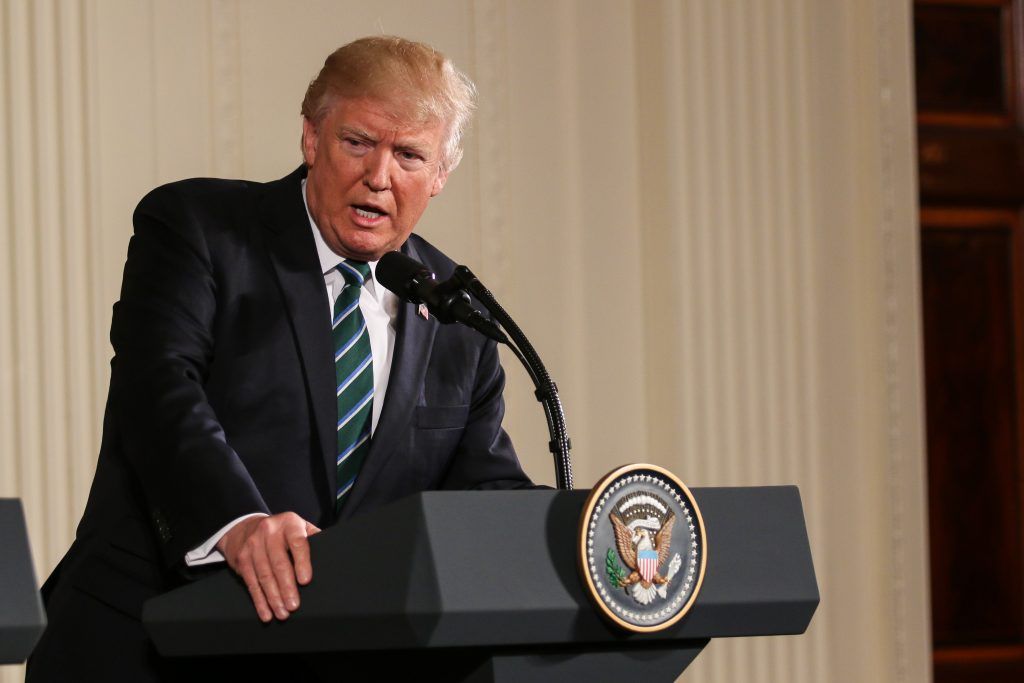An expert proposal: How to limit presidential authority to order the use of nuclear weapons
By Lisbeth Gronlund, David Wright, Steve Fetter | January 8, 2021

Editor’s note: Because of concern about President Trump’s access to US nuclear launch codes in the waning days of his administration, we are republishing this 2018 article by three noted nuclear weapons experts, one of whom, Steve Fetter, is a member of the Bulletin‘s Science and Security Board.
In the United States, the president has sole authority to order the use of nuclear weapons, for any reason and at any time. This arrangement is both risky and unnecessary.
The risks are not hypothetical. During the Watergate scandal, President Nixon was drinking heavily and many advisers considered him unstable. During the 1974 impeachment hearings, Nixon told reporters that “I can go back into my office and pick up the telephone and in 25 minutes 70 million people will be dead.” Defense Secretary James Schlesinger reportedly instructed the Joint Chiefs of Staff that “any emergency order coming from the President”—such as a nuclear launch order—should go through him or Secretary of State Henry Kissinger first. But Schlesinger had no legal authority to intervene, and it is not clear what would have happened if Nixon had ordered an attack.
The United States should modify its decision-making procedures to require that one or more officials concur with a presidential order to use nuclear weapons before the military carries it out. Implementing such a requirement is readily accomplished using a tracking system operated by the Federal Emergency Management Agency (FEMA).
The FEMA succession tracking system. FEMA continuously tracks the location of officials in the presidential line of succession. This system was set up to ensure that if the president dies, is incapacitated, resigns, or is removed from office, presidential authority devolves to the next person in the line of succession, thereby maintaining continuity and stability in the US government.
Although established to track those in the presidential line of succession, the FEMA system could also be used to track other government officials whose agreement was required for a launch order to be carried out. The FEMA system would allow the Pentagon’s National Military Command Center (the “War Room”), which would convey an order to use nuclear weapons to the crews that would carry it out, to quickly establish secure communications with these other officials. (See “How a nuclear attack order is carried out now.”)
In extreme situations in which the War Room could not communicate with other officials, this new decision-making process could be designed to revert to the current one in which the president has sole authority. In this way, this process would not raise doubts about the ability of the United States to respond to a nuclear attack.
We propose that the use of nuclear weapons would require an order from the president and agreement by the next two people in the presidential chain of succession. Under normal circumstances, these two people would be the vice president and Speaker of the House. Our proposal applies to any use of nuclear weapons, regardless of whether it would be the first use of nuclear weapons or in response to a nuclear attack or warning of an attack.
The president would choose the attack option (presumably in consultation with his or her advisors) and issue the order, but the National Military Command Center would execute the order only if the other two officials agreed. This would avoid the need for developing consensus on the exact attack plan, but still allow either of the two others to veto the plan. These two officials should consider two factors in deciding whether to concur with the planned attack.
First, the order must be valid. While the duty officer at the National Military Command Center confirms that the person ordering the attack is actually the president, he or she is not in a position to judge whether the president is mentally fit. The two officials involved would be in a better position to assess the president’s state of mind and could veto the launch order if they judged the president to be mentally unstable or otherwise unfit to give such an order. A veto would be compatible with the 25th Amendment to the Constitution, which allows for the removal of the president from office if the vice president and a majority of the Cabinet deem him or her physically or mentally “unable to discharge the powers and duties of his office.” Because there likely would not be sufficient time to implement this provision of the 25th Amendment to prevent an unstable president from ordering a nuclear attack, the option of vetoing a launch order provides a necessary safeguard.
Second, the attack must be lawful. All US military operations—including the use of nuclear weapons—are governed by the Law of Armed Conflict (LOAC), which requires that any use of force comply with three basic principles: military necessity (attacks must be limited actions necessary to accomplish legitimate military objectives); distinction (attacks must discriminate between military and civilian targets; and proportionality (the military objective must outweigh the harm caused to civilians). All members of the military are charged with upholding these principles, even if it requires disobeying orders from superiors. Personnel who violate the Law of Armed Conflict are subject to court martial; military leaders may be charged with crimes against humanity and tried as war criminals in international fora.
The Defense Department takes these requirements seriously, as reflected by its 1,200-page 2015 Law of War Manual, which was produced by the department’s Office of the General Counsel. To ensure that military leaders and commanders apply these principles, the Defense Department requires “that qualified legal advisers are immediately available at all levels of command to provide advice about law of war compliance during planning and execution of exercises and operations.” Military lawyers—called judge advocates—are assigned to each of the commands and advise the commanders about the legality of operations, including real-time operations in the field.
Even though the use of nuclear weapons is governed by the Law of Armed Conflict, it seems doubtful that anyone in the National Military Command Center is tasked with assessing the lawfulness of a launch order before sending it out. (The authors have changed their conclusions about this part of launch procedure; see editor’s note below[1].) The task of the war room is to encode and distribute the order to the launch crews and aircraft pilots. Under our proposal, the two officials would have to explicitly make a judgment about the lawfulness of the attack. This would be an important addition to the current process.
Thus, the National Military Command Center would execute an order to use nuclear weapons only if both officials judged that the order met both criteria—that it is valid and lawful.
A better process for authorizing the use of nuclear weapons
Who: If the president dies, is incapacitated, resigns, or is removed from office, presidential authority devolves to a specified list of eligible officials. The top six people in the chain of succession are:
- Vice-president
- Speaker of the House of Representatives
- President Pro Tempore of the Senate
- Secretary of State
- Secretary of Treasury
- Secretary of Defense
These are followed by the remaining members of the cabinet, in the order that the cabinet positions were created historically.
How: FEMA continuously tracks the location of officials in the line of succession, to allow them to be contacted quickly. FEMA is also tasked with keeping track of the status of these people, so it can determine who is the president or acting president at any time. It uses a system called the Internet Protocol Locator, which in 2009 replaced the Central Locator System.
In the event the president and others in the chain of succession die or are incapacitated, this system today allows the War Room to know who is the top person in the chain of succession—and hence the president—and to authenticate and carry out a launch order issued by this person. To be able to assume presidential nuclear authority quickly, the vice-president has his or her own football that provides the launch options, authorization codes, and secure communications equipment necessary to order the use of nuclear weapons.
For example, on occasions when many of the officials in the line of succession will be in the same location, such as attending a State of the Union address, one official is chosen to be the “designated survivor.” During this period, this person stays at a different location, in case there is an attack that kills or incapacitates those in the line of succession above him or her. The official is accompanied by someone with a football and a biscuit with the authorization code—which he or she will retain if the officials higher in the line of succession are all killed or incapacitated.
Because the War Room will know which officials in the line of command are alive, and therefore who the president is, it will know which authorization code is valid.
If the US government is confident that the current system would allow a quick and smooth transfer of launch authority if the commander-in-chief were killed or incapacitated, it should also be confident that this system would allow a small number of additional officials to affirm a launch decision by the president.
Exceptions to the Process: In almost all circumstances, there would be sufficient time for the War Room to communicate with these officials, and for these officials to consult with each other (and advisors), to consider the options and consequences before making a decision. There may be two exceptions:
- A massive surprise nuclear attack by Russia. If the War Room is unable to communicate with the president and two people on the succession list, an attack could be ordered by the most senior person with whom the War Room had maintained communication (who would presumably have become president). It would require agreement by up to two additional officials from the chain of succession only if the War Room were able to communicate with them in a timely manner. If the War Room was not able to communicate with two others, the launch could be authorized by the president and one other person, or by the president alone. Because the process would revert to the current one in which the president has sole authority to order a launch, implementing this system would not reduce deterrence against a massive Russian surprise attack. Note that this situation only pertains to a “bolt-from-the-blue” surprise attack. During a time of high tension, the United States would increase its alert level, which would include taking steps to make secure communication with officials in the line of succession possible, even after a massive Russian attack.
- A US launch of its silo-based ballistic missiles on warning of an incoming Russian attack. The United States maintains silo-based missiles on high alert so they can be launched if data from early warning satellites and radars, together with other information, indicate an incoming Russian attack. Such a launch-on-warning posture would give officials less than 10 minutes to make a launch decision. Because the War Room can reach people on the succession list quickly, this should still leave time for three people to be involved in a launch decision. If, however, it is not possible to reach the president and two others, a decision could be taken by the president and one other person, or by the president alone if necessary.
Why: We believe that requiring the involvement of people in the presidential succession list in nuclear use decision-making has three important advantages.
Political legitimacy: These people have political legitimacy to take part in a decision to use nuclear weapons because they are designated by law to become commander-in-chief and assume the authority to order a nuclear attack if the officials above them were no longer in power.
Democratic input: The top three officials in the line of succession are elected and two of them are members of Congress. Unless several top officials died or were incapacitated, under our proposal at least one congressional leader would need to agree with an order to use nuclear weapons. While this falls short of requiring congressional approval for the use of nuclear weapons (as legislation sponsored by Massachusetts Sen. Ed Markey and Rep. Ted Lieu of California requires for the first use of nuclear weapons), it would provide democratic input.
Independence: The top three people in the line of succession cannot be fired by the president. In contrast, cabinet secretaries and other political appointees serve at the pleasure of the president, who can dismiss them at any time. The president could fire political appointees who disagreed with his or her decision to use nuclear weapons.
Other proposals. Rather than include officials from the presidential line of succession in a launch decision, some analysts have suggested involving other officials. National security experts Richard Betts and Matthew Waxman have proposed that the attorney general and secretary of defense be involved in the case of nuclear first-use. Alternatively, the secretaries of defense and state could be required to agree with a launch order. In both cases, the FEMA system described above could be used to track and communicate with these officials.
In the Betts and Waxman proposal, the decision process would require “certifications from the secretary of defense or designee that the order is valid (definitely from the commander in chief) as well as from the attorney general or designee that it is legal.”
Under this proposal, the requirement for certifications by the cabinet members would apply only to the situation in which the president ordered the first use of nuclear weapons and not “under conditions of enemy attack,” because they believe the requirement could lengthen the authorization process. Using the tracking and communication system discussed above would make it possible to extend their scheme to all decisions about nuclear use.
But as noted above, cabinet officers serve at the pleasure of the president and can be dismissed. The president could fire these officials if he or she could not gain their approval and could fire their replacements until he or she got the approval he or she was seeking.
Additional steps to limit presidential launch authority. We recommend two additional steps that would limit the circumstances under which the president could order the use of nuclear weapons.
First, the United States should remove its silo-based missiles from high alert and eliminate the option of launching its nuclear weapons on warning of an attack. Instead, the United States would launch nuclear weapons only if the detonation of nuclear weapons against the United States or a US ally was confirmed. This would eliminate the risk that the United States could launch nuclear weapons based on erroneous or misinterpreted warning of nuclear attack and reduce the need for the president to make a nuclear launch decision under extreme time pressure.
Note that even if all US silo-based missiles were destroyed, the United States would retain the option of responding with a massive nuclear attack. The majority of US nuclear weapons—those based on submarines at sea—are able to survive a first strike. Submarines hidden at sea cannot be targeted and the United States has taken—and is continuing to take—steps to assure that communication with submarines would also survive a first strike.
Second, the United States should declare that it will not initiate the use of nuclear weapons, and that the sole purpose of US nuclear weapons is to deter and, if necessary, respond to the use of nuclear weapons against the United States or its allies. Over the last several decades, the United States has narrowed the circumstances under which it would consider using nuclear weapons first, and at the end of the Obama presidency, Vice-President Joe Biden stated that “it is hard to envision a plausible scenario in which the first use of nuclear weapons by the United States would be necessary or make sense.” While the Trump administration appears poised to increase the circumstances under which the United States would use nuclear weapons first, Congress could take an important step to support a no-first-use policy by passing the bill introduced by Representative Adam Smith stating it is US policy to not use nuclear weapons first, or the Markey-Lieu bill, which would require that Congress declare war and authorize the first use of nuclear weapons before the president can order such an attack.
Notes
[1] Editor’s note: Based on further research, the authors now believe that the Command Center leadership (along with other Pentagon leaders) would assess the lawfulness of any presidential launch order before carrying it out, so the two other officials who would have to consent to a launch order would not need to make this assessment. See https://inkstickmedia.com/presidents-do-have-limits-on-nuclear-use-but-need-more/.
Together, we make the world safer.
The Bulletin elevates expert voices above the noise. But as an independent nonprofit organization, our operations depend on the support of readers like you. Help us continue to deliver quality journalism that holds leaders accountable. Your support of our work at any level is important. In return, we promise our coverage will be understandable, influential, vigilant, solution-oriented, and fair-minded. Together we can make a difference.
Keywords: nuclear codes, presidential nuclear authority, sole authority
Topics: Analysis, Nuclear Weapons
















